BY HUGO PINKSTERBOER – HISTORY OF CYMBALS
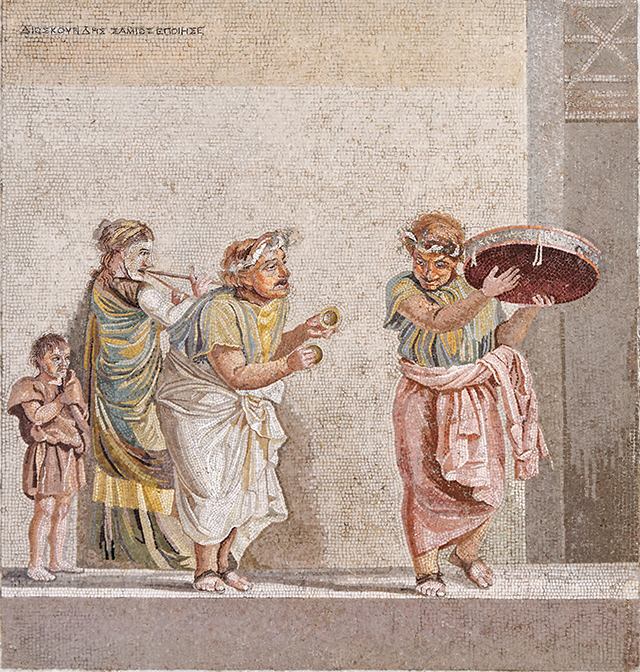
Roman mosaic from the Villa del Cicerone in Pompeii.
IN THE BEGINNING
The tendency to hit things that might produce a sound in return isn’t reserved to drummers only, so it’s safe to say that the earliest forebears of the cymbal were made around the time bronze came about, around 3,000 B.C. Judging from the many stories on the use of the instrument in those early days, people soon discovered how versatile it really is.
While modern-day cymbals can be heard in classical music, rock, jazz, Latin, and pretty much any other Western style of music, their predecessors were used by beggars to attract the attention of potential benefactors, to celebrate weddings, to add luster to orgies, to tell bees to come back to their hives, and to worship gods.
If you think of the cymbals as a bronze disc with a hole in the middle, the instrument hasn’t changed a bit over the past, say, 5,000 years. At the same time, a whole lot of things have changed over the past, say, 30 years. An explosion of new cymbal makers, and an even heftier explosion of cymbal types and sounds have radically altered the face of the market in the past three decades.
A contradiction? Not in the world of cymbals, the most basic yet complex instrument we know. Let’s take a closer look, starting with a bit of history.
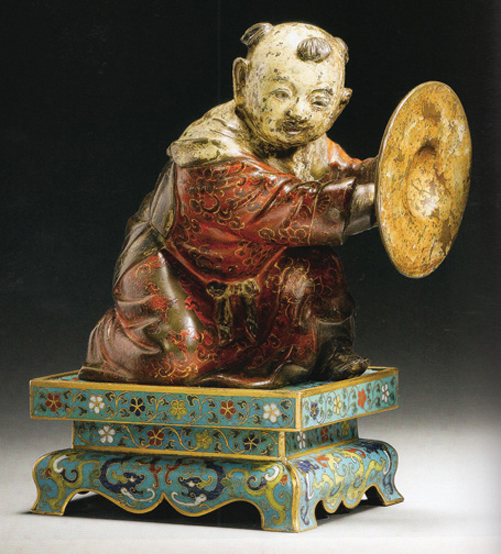
Ming Dynasty art (17th century).
MAN AND HIS CYMBALS
James Blades, in his book Percussion Instruments And Their History, mentions Dionysus as an example. “The Greek god of wine, women, and merriment …” contemplated the late drummer Arthur Taylor. Taylor obviously liked him, and if you listen to his inspired drumming on John Coltrane’s Giant Steps, that Dionysian influence is clear.
What isn’t clear is where the first cymbals were made. Tibet, India, and Turkey, perhaps, or maybe China, where soldiers scared the living daylights out of their adversaries with a cacophony of clashing cymbals. The instrument reportedly was used for the same purpose in Korea as recently as 1950.
Did you know that the characteristic cup of China cymbals wasn’t designed with a particular sound in mind, or to force you to mount them upside down? The cup simply functions as a handle, allowing the “musician” to bash two cymbals against each other.
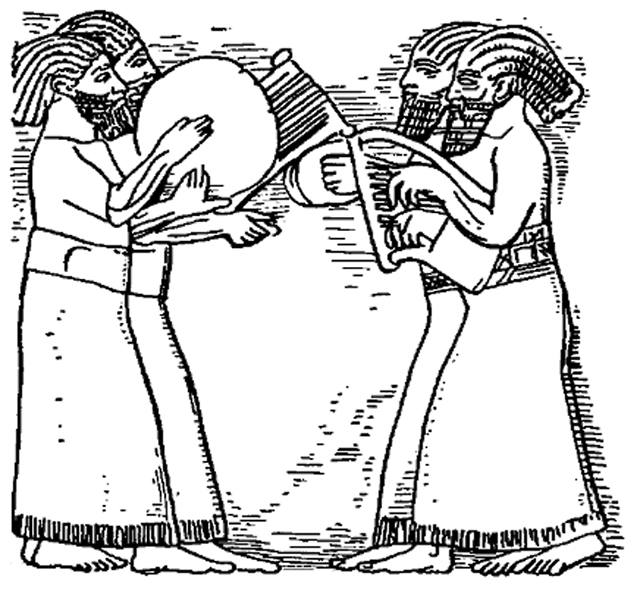
Assyrian Quartet.
As music evolved from its military applications and its ritual use in churches and palaces, roughly around the 17th century, cymbals weren’t forgotten. The German composer Nicolaus Strungk was the first to use cymbals in an opera orchestra, in the year 1680 — and we can only hope this didn’t contribute to the fact that the man left his family heavily in debt when he passed away.
Haydn and Mozart sparsely used cymbals some 100 years later, but they weren’t considered serious musical instruments until the latter half of the 19th century. Until that time, they were always played in pairs. Hector Berlioz was probably the first composer who had a suspended cymbal played with sticks.
That sounds as progressive as it was in those days, but even Berlioz couldn’t take two steps at a time: He stated that the combined sound of a cymbal and a bass drum was “only fit to have monkeys dance to.”
One can only wonder how much slower the modern-day cymbal would have evolved if Avedis Zildjian hadn’t moved from Istanbul to Boston, in 1908, where he eventually started his own factory. A candy factory, that is. In the late 1920s, his uncle Aram sent him a letter from Istanbul asking him to take over the Zildjian legacy in the late 1920s.
Avedis was reluctant, being perfectly happy making candy. “At first he said: ‘Jesus, that’s a romantic story. You couldn’t make a living of it,’” recalled his son, Armand Zildjian, in The Cymbal Book. “It was my mother who inspired him to try it anyhow.” Jazz was developing at their doorstep, so to speak, and so was the art of drum set playing. The timing couldn’t have been any better.
Initially, the Avedis Zildjian Company made no more then some six cymbals a day. Things expanded as drummers discovered what was going on at 39 Fayette Street, Norfolk Downs, Quincy, Massachusetts (you can still pay that street a visit). Gene Krupa, in his early twenties around that time, was one of the first drummers who explicitly asked Avedis to make thinner cymbals. Drummers loved the results, according to Armand Zildjian: “Krupa, Papa Jo Jones, Chick Webb … They were all wild about these new cymbals.”
SIZING UP
Drummers used relatively small cymbals in those days. A British book from 1934, Max On Swing, mentions how, “If you can afford only one cymbal, then buy a 12″ one. This should not be of the thick type, nor should they be, in my opinion, of the extreme ‘paper-thin’ kind .… If your pocket allows you to run to more than one cymbal, then you should next possess yourself of an 11″ cymbal, slightly thinner than your first, and of a little higher pitch …. If you can still go to another, then you may indulge in the extra luxury of a 10″ or 11″ paper-thin instrument; there are many fine effects possible with cymbals of this nature.”
In the latter part of that decade, sizes had gone up a bit. Gene Krupa used 8″ and 13″ thin cymbals, 13″ and 14″ mediums, and a pair of 11″ hi-hats in his big band. The terms “ride” and “crash” had not yet been coined. Even in 1948, the Avedis Zildjian catalog simply listed 20 cymbal sizes, ranging incrementally per inch from 7″ to 26″, available in Paper Thin, Thin, Medium Thin, Medium, Medium Heavy, and Heavy. The note “sizes cannot be guaranteed to be accurate” in that same catalog clearly indicated that cymbals were truly handmade instruments.

Bacchante Playing The Cymbals by Jean-Simon Berthélemy, 18th century.
The fact that no one spoke of ride cymbals in those days can easily be explained: Nobody was playing a “ride” pattern on a cymbal until the mid-1940s, when bebop pioneer Kenny Clarke shifted his time keeping from the hi-hat to a suspended cymbal. According to Clarke, the move from the hi-hat to the ride opened up the whole drum set in a new way. Opening up the instrument was not what everybody was waiting for, apparently: Clarke got fired from many a gig in those days.
Cymbals had been getting bigger and bigger throughout that decade: Big band leader Stan Kenton wanted his drummers to play 24″ rides and 22″ crashes, and a few years later even 28″ rides and 18″ hi-hats were available. While specific types of rides had been marketed, such as the Bop Ride and the Ping Ride, the term “crash” wasn’t commonly used until the early 1950s. Some drummers never really accepted those definitions: “Every cymbal I use is a ride cymbal,” says Mel Lewis in The Cymbal Book. “Every one of my cymbals is also a crash cymbal. I only use three. Three is enough.”
So what about the hi-hat in those early days? This essential piece of equipment was preceded by the “clanger,” basically a metal beater that was attached to the bass drum beater. It hit a vertically mounted cymbal on every bass drum note.
Then came the “snow-shoe,” consisting of two hinged wooden boards with a pair of cymbals on one end. Around 1925 drummer Vic Berton devised the lo-hat, lo-sock, or lo-boy, essentially a hi-hat but no more than some 15″ high. The small (around 10″) cymbals featured a large cup, which explains the “lo-hat” name. It is unclear who came up with the splendid idea of using a longer tube, allowing drummers to play the hi-hat with sticks as well, but Papa Jo Jones was quoted saying “It was through necessity that I went and got a pipe. I couldn’t go down and play the sock cymbal on the floor.”
It isn’t surprising that Jo Jones is known as the first drummer who kept time on the brand new hi-hat, rather than on the snare drum. As a result, the cymbals slowly got bigger, with smaller cups, creating a larger time-keeping area. In the late ’40s, a suggested bebop setup of that time contained 15″ hi-hats, a 22″ medium ride, and a 15″ thin cymbal.

Turkish finger-cymbal performer from 1851.
LOUDNESS WARS
The first rock drummers played the same cymbals that their jazz colleagues used. The undefined shhhh sound on 1960s pop records was not by choice; it was just all there was — and that was definitely not enough to cope with amplified guitars. Paiste responded to the need for louder cymbals with its aptly named Giant Beat series in 1965. Two years later, the same company introduced its Sound Edge hi-hats. The bottom cymbal with its corrugated edge, later copied by various other cymbal makers, provided drummers with a well-defined hi-hat sound.
In the years that followed, the cymbal industry (small as it was back then) seemed to focus on louder cymbals only. At the same time, rock and funk drummers shifted time-keeping back to the hi-hat, for maximum definition. Jazz drummers were largely ignored, apparently, and many of them were probably playing Turkish-made K Zildjians, the much sought-after “old K’s.”
But handn’t Zildjian moved to the U.S.? Well, yes: Avedis did — but the descendants of Kerope II, who died in 1909, were still making cymbals in Istanbul. Without going into detail in this limited space, it should be mentioned that those Istanbul cymbal makers were not Zildjians, officially. The company was run by Gabriel Dulgaryian, who had married Akabi Zildjian, and by their son Mikhail later on.
As Armenian family names at one point were forbidden, the Dulgaryians changed their name to Zilciyan or Zilçan, pronounced as “Zilch-ian” in Turkish. Sound familiar?
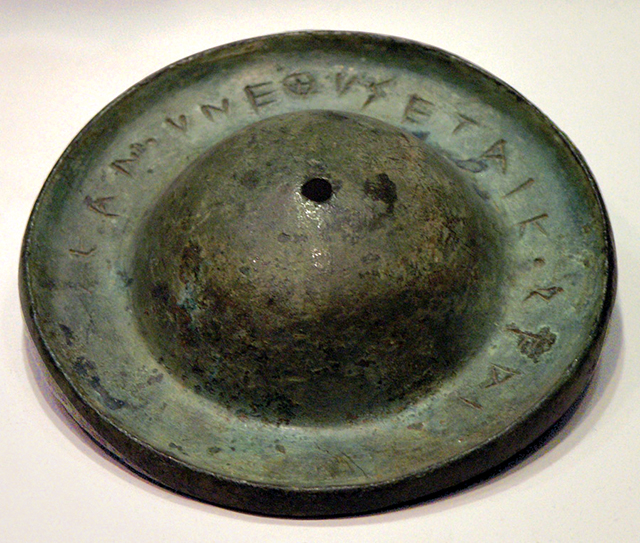
Cymbal from Athens, Greece, c. 450 B.C.
It was this Mikhail Zilçan who taught the art of cymbal making to two young men who had started working in the company at the early age of seven or eight, fetching water for the cymbal smiths. When the Avedis Zildjian Company, having gained back all Zildjian trademarks, closed the Istanbul factory in the late ’70s, it was these two men who started the first of a whole new generation of Turkish cymbal companies: In 1981 Mehmet Tamdeger and Agop Tomurcuk founded Zilciler (“cymbal smiths”).
Using the same name on their cymbals, in a style that clearly resembled the Zildjian logo, led to a lawsuit. Zilciler lost, but the trial generated more publicity in the music industry than any ad campaign would have done. Tamdeger and Tomurcuk renamed their products Istanbul. Mel Lewis was one of their first endorsers, and he was extremely pleased with the fact that the new company did not focus on definition and volume, but on soul and sound. When he first heard them, he supposedly said: “My God, they’re back!”
THE RISING SWELL
After the closure of the Turkish Zildjian factory, drummers had an extremely limited choice of cymbal suppliers. The two largest companies of that time made no more than four cymbal series: Avedis Zildjian had its A (for Avedis) series, and the Paiste catalog listed the rock-oriented 2002 series, the recently released Formula 602 cymbals (featuring the classic Medium Flat Ride), and the experimental Sound Creations. Add two series from the Italian UFiP company and some entry levels from Meinl, and basically, that was it. And then, in 1981, things changed.
While Tamdeger and Tomurcuk started Zilciler, Robert Zildjian founded Sabian, probably the fastest growing cymbal company ever. In the few years that followed, Meinl moved into higher price ranges, Zildjian started making its all-American K series, Paiste released its Color Sounds, and things went up from there. Within 12 years, 8 companies introduced some 30 new cymbal series, the 3 major brands (Paiste, Sabian, and Zildjian) offering drummers some 250 different ride cymbals and 350 crashes. A whole lot, seemingly, but a drop in the bucket compared to today’s standards.
1996 was another year to remember in cymbal history. First, in March of that year, Mehmet Tamdeger’s cousins Yücel Uluç and Nusret …zevin founded Turkish Cymbals, a second Istanbul-based cymbal maker. A mere three months later, Agop Tomurcuk died in an accident.
His two sons, Arman and Sarkis, decided to strike out on their own. As both companies had equal rights to the Istanbul name, they called their company Istanbul Agop, honoring their dad. Mehmet Tamdeger stayed as head of the original company, now known as Istanbul Mehmet. (As far as is generally known, Mr. Mehmet is the only cymbal smith alive who learned the craft in the “old” K Zildjian factory.)
Yet another company was founded in that same year, Bosphorus. Its American connection helped this company in attracting name endorsers (e.g., Jeff Hamilton) long before its fellow companies succeed in doing so. As a drummer, you probably know the evolution of the Turkish cymbal market didn’t stop there: almost every year, a new Turkish maker shows up. Names include Masterwork, Agean, Saluda, Symnra, Soultone, Supernaturals, Amedia, Murat Diril, Ibrahim Diril, and TRX (see the complete directory of current manufacturers on pg. 65).
The Turkish cymbal revolution has left its traces around the world, and the old traditions have even influenced the Swiss/German cymbal companies: both Paiste (Twenty Series) and Meinl (Byzance) market series that use Turkish-made cymbal blanks. Twenty years before, no one would have believed this would ever happen: Both companies were strongly rooted in their own “European” way of cymbal making.
But times have changed. Perhaps even more for Meinl than for any of the other companies. Traditionally, Meinl had always focused on low-budget cymbals. “We’re not bothered by secret recipes or old traditions, and we’re happy about it. After all, it’s just a metal disc we’re talking about,” said a Meinl spokesman in the late 1980s.
In those days, Meinl explicitly marketed cymbals of the most common sizes, in the most common weights, and the most common models. “We make cymbals for the drummers in the audience, rather than for the drummers they love,” said Reinhold Meinl in those days. And while other companies stressed the beauty of the individuality of their cymbals, Meinl was proud of its computer-controlled machines that produced exact replicas of its standard models only.
They still are and they still can — but it’s no longer all Meinl does. One of the series that marked the beginning of its new approach was the 1996 Custom Shop series, a series that allowed drummers to choose numerous combinations of size, finish, hammering patterns, types of lathing, rivets, and more: quite the opposite of what Meinl used to offer. And of course, the company now promotes its artists as much as any other cymbal company.
In the meantime, things changed in China, as well. Of course, Chinese companies still make the traditional cymbals with their triangular cups, their upturned edges, and their aggressive sound that scares enemies as much as nearby band members. But that’s not all: Companies such as Dream and Stagg show that Chinese cymbal makers can make Western-type cymbals just as well. Some may argue they’re actually better at it than Western cymbal makers are at reproducing the authentic Chinese cymbal.
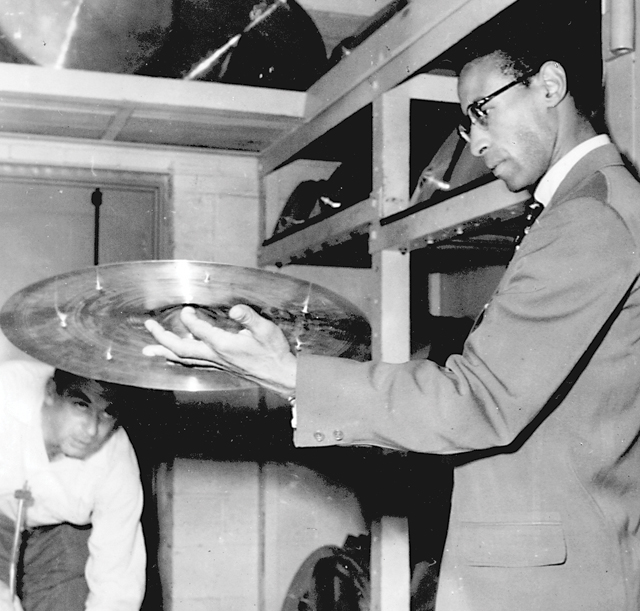
Armand Zildjian with Max Roach, c. 1950.
THE TYRANNY OF INFINITE CHOICE
The number of types of cymbals produced and marketed today is enough to drive drummers crazy — and it’s best for everyone’s sake that most drum stores do not stock more than a few of the available brands at a time. Still, there are drummers who just can’t find what they’re looking for. If you’re one of them, you may want to check out the work of the few artisan one-man cymbal-makers around.
Robert Spizzichino, who passed away in November 2011, is probably the best-known artist of his kind. Spizz, as he’s known, worked at Ufip for a number of years, and then decided to craft his own cymbals, using blanks or even finished cymbals from other makers. Another well-known name is Michael Paiste, son of former Paiste president and sound designer Robert Paiste.
While he was active in Paiste Sound Development, Michael was always happy to hear drummers say they liked Paiste cymbals, but drummers who asked for something just a little different simply intrigued him more. As a result, he decided to start making his own cymbals, and he still does. Like Spizz, Michael uses blanks made by other companies, and he also customizes finished cymbals.
In fact, the small community of one-man “artisan” cymbalsmiths has experienced a renaissance in the last several years, with unique offerings from the likes of Matt Nolan, Matt Bettis, Steve Hubback, and the late Mike Skiba, creator of Cymbalholic.com (who passed away almost exactly a year before Spizz). Meanwhile, John Stannard of Hammerax, arguably one of the most intriguing sound shapers working in the field of cymbals and gongs today, is gaining a level of commercial recognition with recent offerings that is bringing his products out of the boutique realm and into the mainstream.
So many cymbals, so many sounds, so many drummers. Drummers who, baffled by the overabundant number of choices, may forget that they’re in control of their sound as much as their cymbals are. “One guy asked me why I don’t have a China,” Idris Muhammad once told me. “Well, I like China cymbals, but I could play a China sound in the cymbals that I use.
I don’t need another cymbal just to make one sound.” The art of cymbal playing was similarly stressed by the late, great Papa Jo Jones. “That cymbal that I got up there I gave away five times to five different drummers. I told them: ‘I’m going to let you have this for a month. You learn how to play it, you can have it.’ But they ain’t learned to play it yet.”
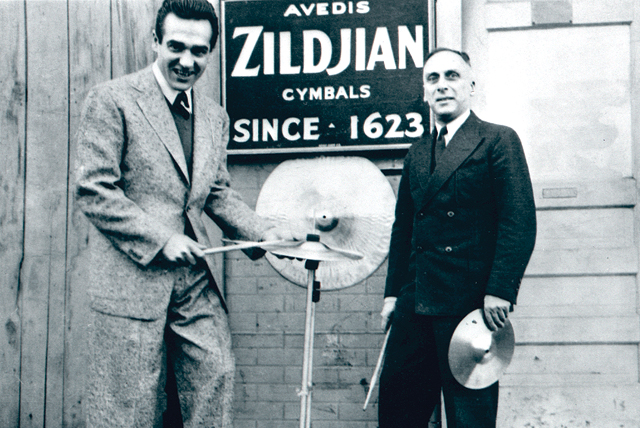
Gene Krupa with Avedis Zildjian, c. 1940.
So you should wonder, perhaps, how much time you should spend selecting cymbals. You could even wonder how many different cymbals you need to create your personal sound. Some of the best players in the world never bothered.
When I had the privilege of interviewing Art Blakey, my first and foremost inspiration, I couldn’t resist asking him how he selected his instruments, intrigued as I was by his characteristic big cymbal sound. I’ll never forget his answer: “I just play any cymbal. Always do the best with what you have. It ain’t the cymbal, no way, it’s the person playing it. Just give me a cymbal. I don’t select them. I ain’t got time for that.”
That said, I’m still looking for a cymbal to back up my warped, unbalanced, extremely handmade 18″ old K, because it’s the only 18″ that I can use for delicate, glancing crashes as well as punctuated Latin bell rhythms or washy jazz grooves. Or maybe I should just head back to the woodshed.
